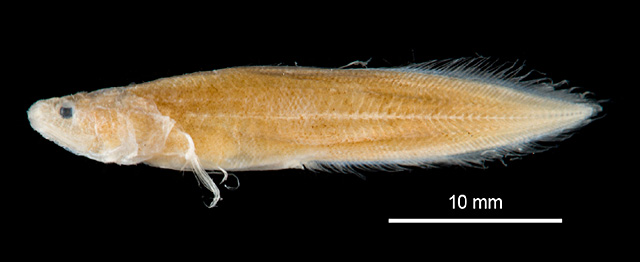| Bythitidae (Livebearing brotulas) |
| 3.35 cm SL (female) |
|
benthopelagic; marine; depth range 8 - 10 m |
| Western Pacific: endemic to New Caledonia |
|
Dorsal soft rays (total): 76-76; Anal soft rays: 60-62; Vertebrae: 48-48. This species is distinguished by the following set of characters: vertebrae 11-12 + 36-37 = 48; dorsal-fin rays 76, anal-fin rays 60-62, pectoral-fin rays 15 or 16, caudal-fin rays 8-9; anterior dorsal fin ray above vertebra 8; anterior anal fin ray below dorsal fin ray 14-15; anterior anal fin ray below vertebra 14; head with continuous scale patches from cheek and opercle to occiput, except for narrow gap between cheek and opercle; papillae few on anterior half of head; forward-curved spine at lower angle of preopercle, hidden by thin skin; posterior mandibular pores 3, lower preopercular pores 1; ver small palatine teeth; elongate otolith, posterior-dorsally expanded, length to height, 2.2; otolith length to colliculum length, 3.5 (Ref. 88975). |
|
|
Data deficient (DD); Date assessed: 16 August 2019 Ref. (130435)
|
| harmless |
Source and more info: www.fishbase.org. For personal, classroom, and other internal use only. Not for publication.
